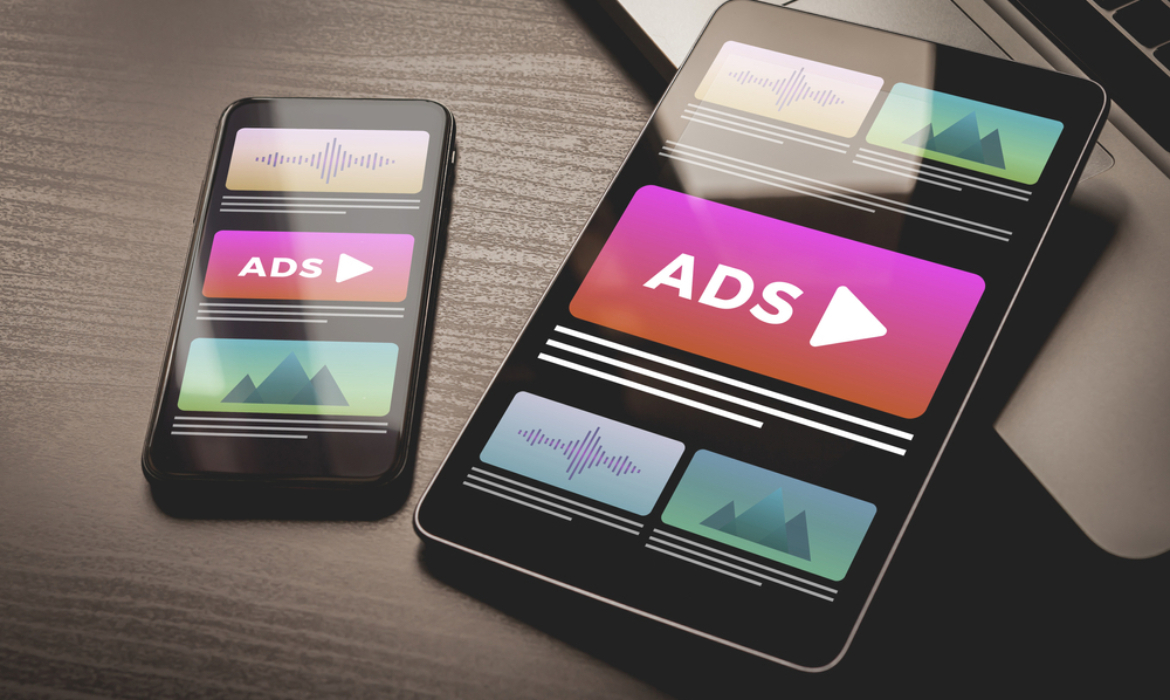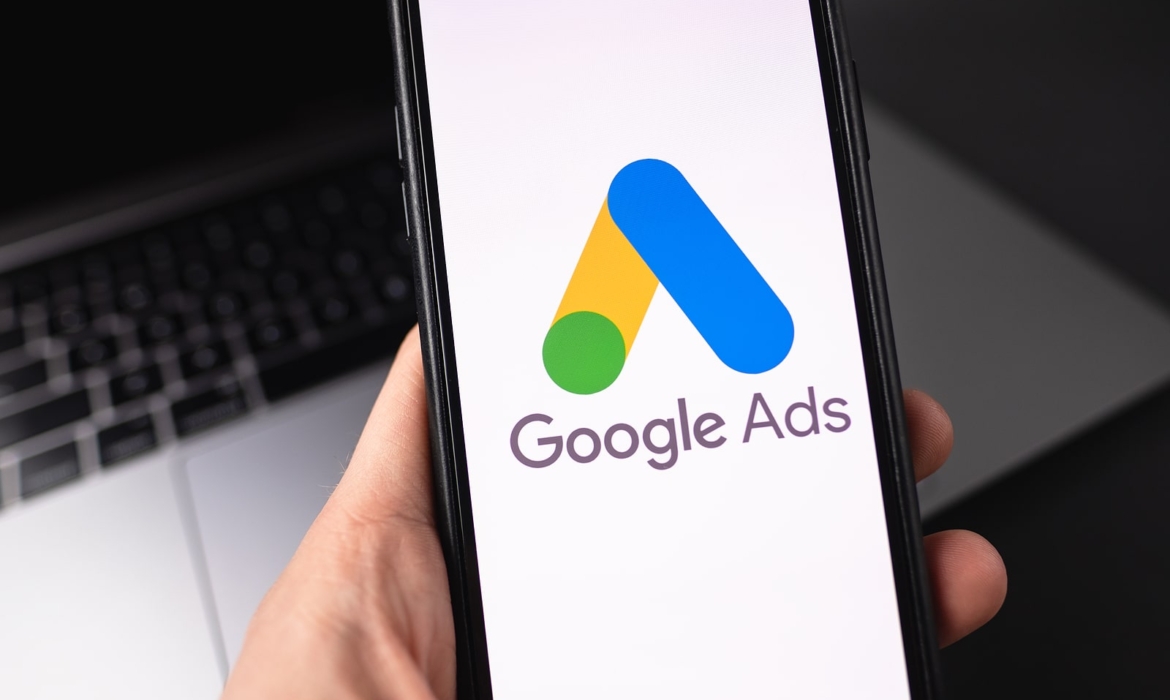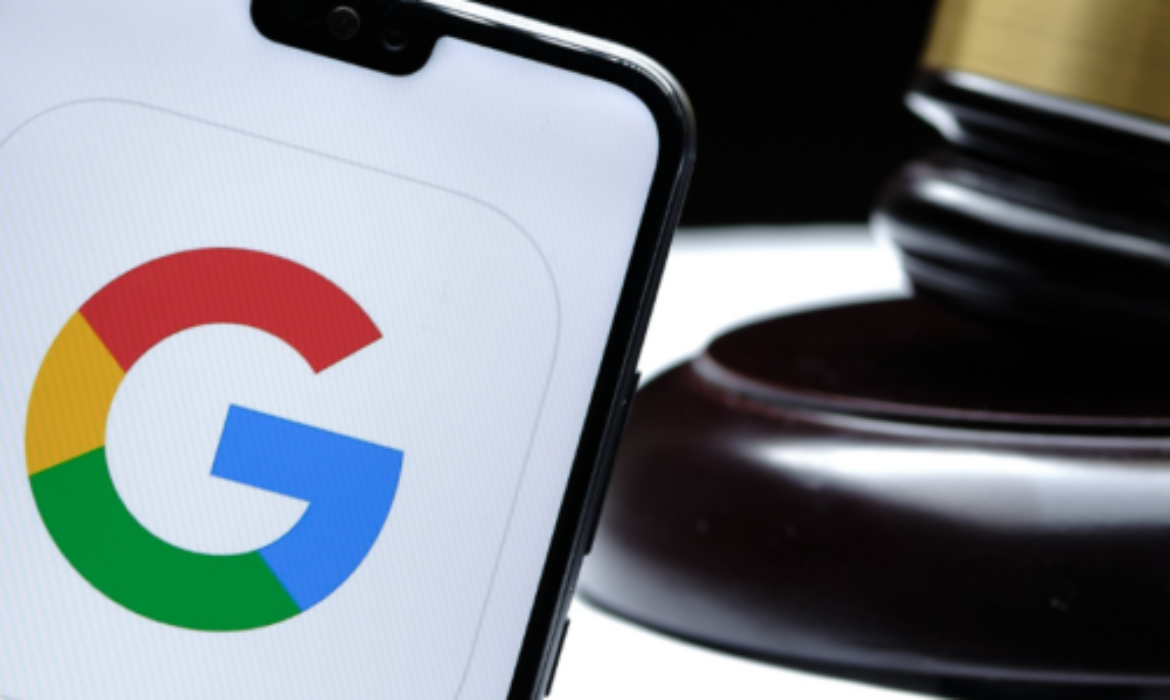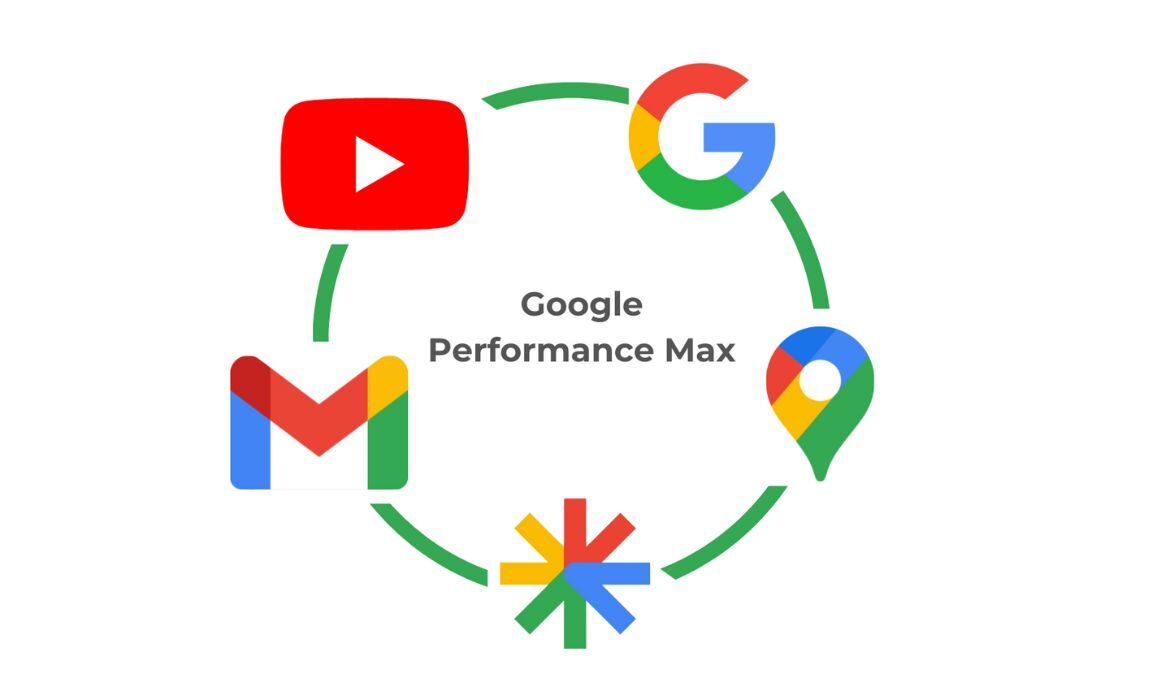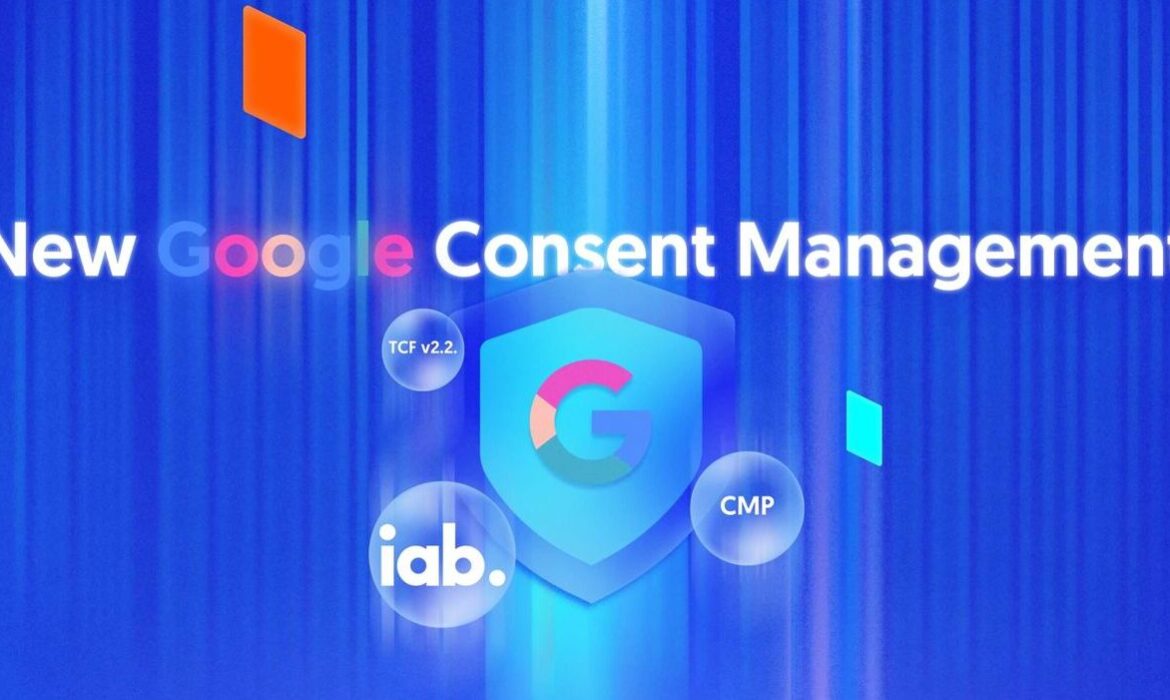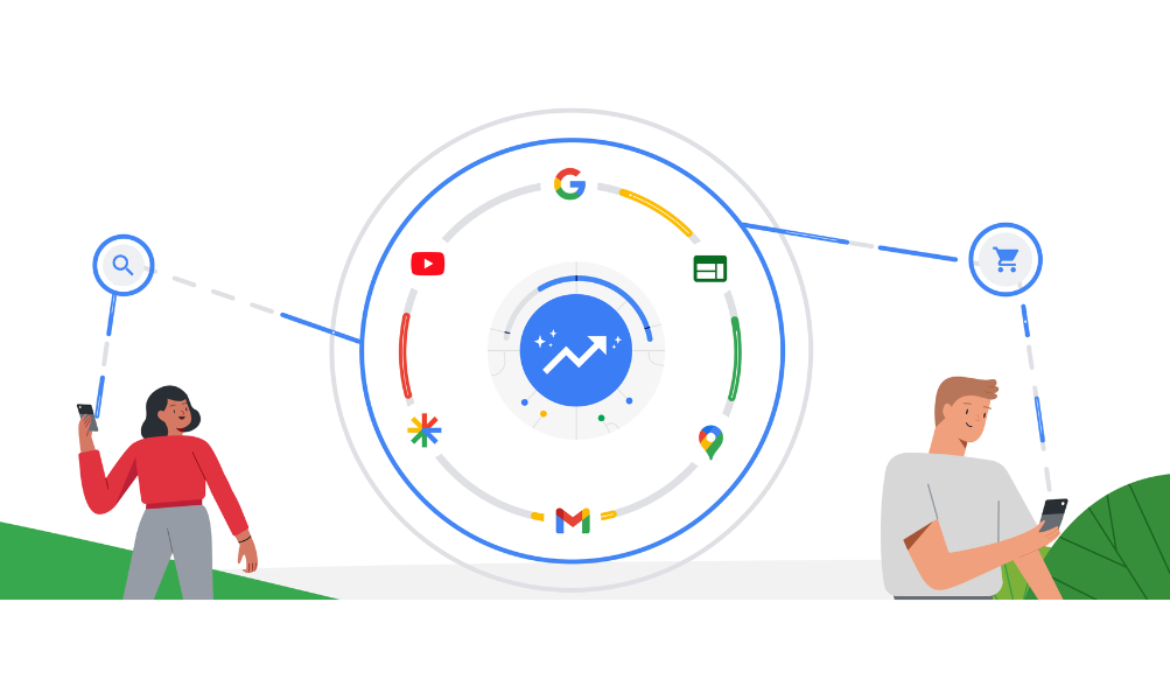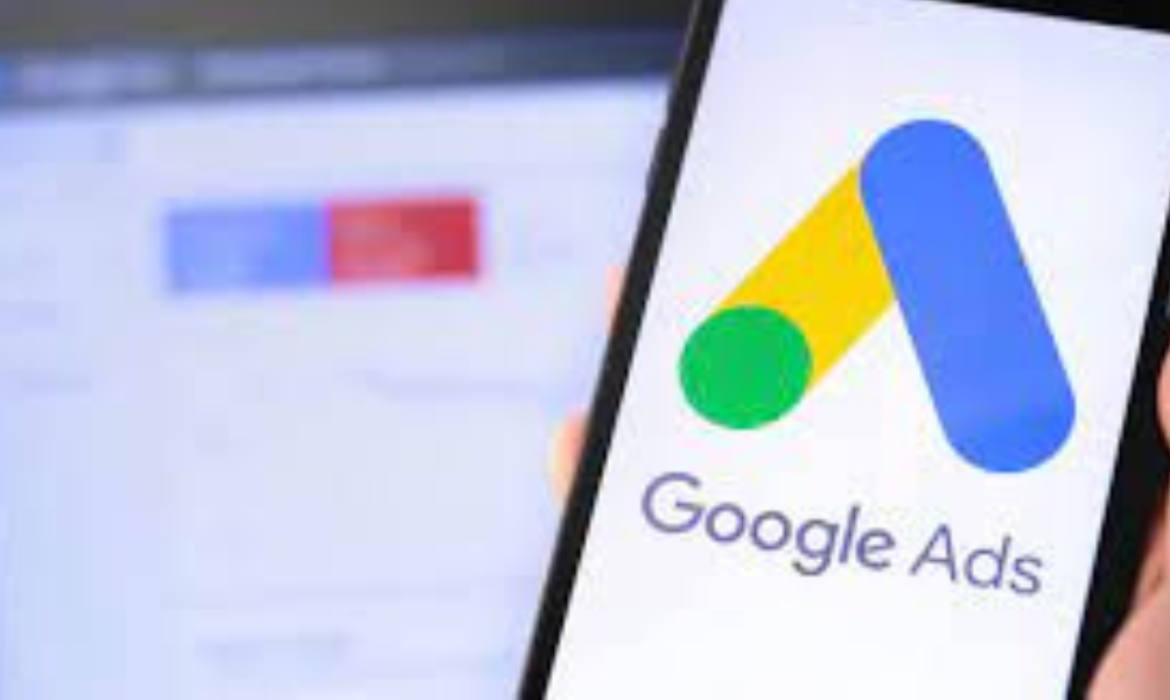Google Plans to Introduce Programmatic Support for Limited Ads
In Q1 2024, Google plans to introduce programmatic support for Limited Ads. The purpose of this new feature is to minimize the use of personal data for ad personalization by giving publishers the ability to serve ads to consumers in a restricted manner. Limited ads prevent personal information from being gathered, shared, and used for personalizing ads. Consequently, some ad features are not available for Limited Ads, including interest-based categories, remarketing, and audience targeting. Publishers who choose to use this new programmatic assistance will be able to profit from the demand for contextual programmatic content coming from
- Google Demand
- Authorized buyers
- Open bidding
- SDK Bidding.
With programmatic demand, this feature gives publishers the opportunity to potentially boost revenue. When choosing whether or not to use invalid traffic-only cookies, it is advisable to consult the legal department for guidance as there may be legal ramifications.
What are limited ads?
In essence, limited ads allow publishers to offer consumers a restricted selection of ad formats. Limited ads accomplish this by disabling the gathering, sharing, and utilization of personal information for ad personalization. Some ad features are not available for limited ads because they disable all personalization of ads that need a local identifier. Among the primary features of the unavailability of ads are:
- Any sort of ad personalization
- Audience targeting
- Remarketing
- Interest-based categories
- Mobile carrier targeting
- Conversion (and in-app conversion) metrics.
Read More: Amazon Prime Video to Introduce Limited Ads in 2024
What is invalid traffic?
Any traffic that is not produced by a real user with a legitimate interest is considered invalid traffic. This can include:
- Accidental clicks caused by intrusive ad implementations
- Fraudulent clicking by competing advertisers.
- Advertising botnets and more.
It’s crucial to remember that Google continues to mandate, without requiring user consent, the use of local storage for programmatic demand and invalid traffic detection-only cookies. Publishers are not required to utilize the new programmatic feature, though. Google recognizes that publishers are subject to different laws and regulations regarding user consent. It is therefore recommended that publishers check with their legal departments to see if this programmatic feature complies with their policies and specifications.
Why do publishers need to consider this?
The new programmatic feature will be enabled by default as soon as it becomes available. Publishers will, however, be able to disable the feature if they so choose. Publishers must consider the possible effects of restricted ad personalization on user experience and revenue generation. Less relevant advertisements may be shown to users, which could affect how they view the publisher’s website. In addition, the lack of personalization could lead to a decline in engagement and a decrease in additional revenue from Limited Ads.
Programmatic bidding on limited ads is now an optional feature on Google since publishers are legally liable for the tools they employ. Moreover, opinions on whether user consent is required for local storage and invalid traffic-only cookies may differ. It implies, in a way, that there isn’t a solution that works for every publisher. Google suggests that in order to decide whether or not to use the new programmatic feature, publishers should consult with their own legal teams.
In summary, publishers should proactively review their current policies and procedures regarding user consent, even though Google has not specified a specific launch date for this feature. If qualified, publishers can decide if using this enhanced programmatic ad-serving feature fits their unique requirements and objectives.
Read More: Google Release Updated Ad Review Centre for its Ad Platforms
Google Launches Google Ads Data Manager for First-Party Data
Google has created an advertising measurement tool that integrates with first-party data from marketers. It is made to function without browser cookies and other data tools that use antiquated techniques to measure performance. The measurement tool, Google Ads Data Manager, will be made accessible in Google Ads from the beginning of 2024. As the business continues to simplify the administration and use of first-party data, the product plan calls for expanding it to additional Google platforms. The tool will make it easier to connect to and utilize first-party data. It centralizes all data management controls, allowing for more income and improved business outcomes.
Google Ads Data Manager for Advertisers
Less than one-third of marketers, according to Google, consistently and successfully access and integrate first-party data across channels. This issue is resolved by Google Ads Data Manager, which streamlines the administration of first-party data connections and the procedure for utilizing that data for commercial purposes. As the advertising business enters the new year and Google deprecates third-party cookies, advertisers will gain knowledge about integrating data sources and protecting consumer data privacy. When it launches, it will make it easier to enable improved conversions for leads and Customer Match from many partners while still maintaining the essential functionality of each service.
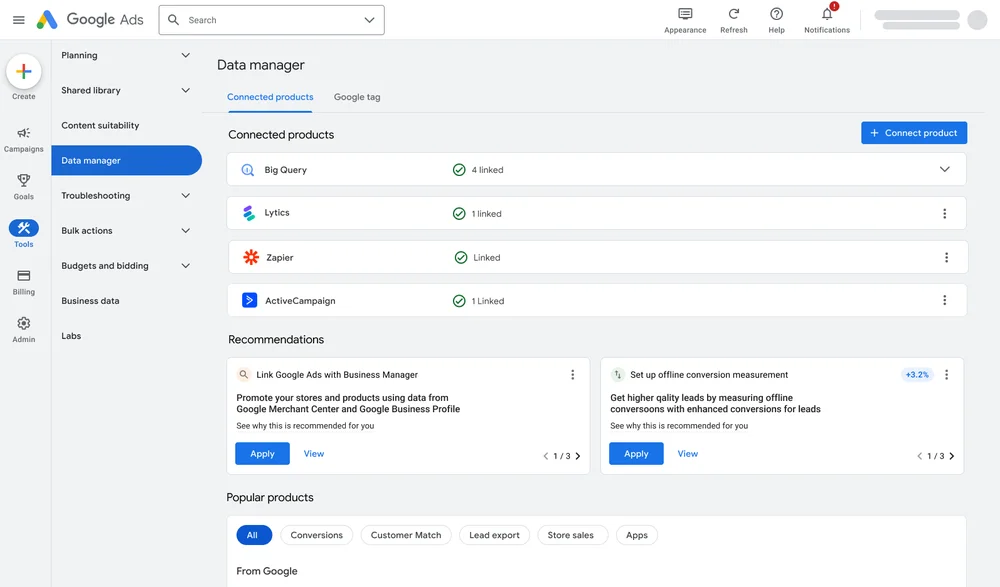
Image credit- Google
Read More: Google Opens Automatically Created Assets Publicly to Boost Efficiency
A number of data sources, such as customer relationship management (CRM) and customer data platforms (CDPs), will be able to be connected by advertisers. Along with marketing tools like Shopify Audiences, this will also incorporate data sources like ActiveCampaign and Pipedrive. If Google Ads Data Manager is a success, it will be simpler to track client interactions with the Google tag and off-website transactions. Instead of altering how Google’s products function, the platform makes it easier for advertisers to use them. Data utilization in marketing is easier because it requires little to no coding expertise.
Benefits of the first-party data measurement tool
Analysts can build new data links using a single collaborative interface. Additionally, marketers can use discrete data to track conversions to target customers with relevant adverts. Zapier and CDPs, such as Lytics, will also provide data sources through cloud-based data storage solutions. Google wants the platform to give users access to all types of data through a single collaborative interface. This will allow analysts to make new data linkages. Furthermore, it will enable marketers to use discrete data to track conversions or target people with appropriate ads
Read More: Samsung Ads and Epsilon Partner for First-Party Data Advancements
Google Opens Automatically Created Assets Publicly to Boost Efficiency
Google has made the most recent improvements to the conversational experience and automatically created assets for Google Ads available to the public. More users will be able to employ AI to increase the effectiveness of marketing campaigns. The new capability is an effort toward automating the workflow for advertising. ACAs were previously restricted to marketers running English-language campaigns during open beta. The ACAs, however, are now offered in seven other languages. In the upcoming months, automatically created assets will begin utilizing generative AI for advertisers with English assets in the U.S. and U.K. Google’s goal is to assist marketers in producing more assets that are better suited to users’ search queries.
A quick look at Automatically Created Assets
Automatically created assets are an opt-in campaign-level setting. Advertisers can select this setting to generate new assets (headlines and descriptions) to be used with the ones they already submitted for responsive advertising. These materials are created based on the specific context of each advertisement, which includes the landing page, current advertisements, and the ad group’s keywords.
Benefits of automatically created assets
Performance
It improves the efficiency of responsive search advertisements (RSA) by automatically adding more headlines and descriptions.
Relevance
Consistently improve the user experience on landing pages, ad copy, and inquiry pages.
Productivity
Reduce the amount of time spent manually writing effective ad copy.

Image credit- Google
Increase in Automatically Created Assets
The extension of automatically created assets is one of the most prominent improvements. Based on the unique context of an advertisement, such as the landing page or previous advertisements, this function generates personalized headlines and descriptions. The aim is to increase the Ad Strength indicator, which measures the efficiency of ads in responsive search campaigns. Marketers can remove any ACA they feel is unsuitable for their advertising. This feature, which was first only available in English, has since been made available in seven more languages. French, Italian, Japanese, German, Portuguese, and Spanish are among them.
ACAs can boost ad relevance by matching ads and landing pages better. However, it entails handing over authority to Google’s AI. For brands with severe compliance rules or industries with heavy regulation, this might not be appropriate. This is because the company won’t have complete control over the message of the advertisement.
Read More: Google Boosts Performance Max with URL Contains Targeting Tool
Utilize ACAs to deliver better-suited search advertising.
Advertisers will have two choices to start employing automatically generated assets:
- Turn them on by using the campaign setting
- On the Recommendations page, locate the “enable automatically created assets” suggestions and simply follow the on-screen instructions to get started
Create better search campaigns with Google Ads’ conversational experience.
The most recent large language model (LLM) innovation powers the conversational experience in Google advertisements. With the use of this technology, advertisers may communicate with Google advertisements in natural language to create campaign pieces. Building search campaigns makes it possible to achieve greater results with fewer resources. All that is needed for a campaign is the advertiser’s website URL, and Google AI will generate the rest. They will receive headlines and pictures from it. Marketers can interact with AI during each session to change suggestions and approve them prior to launching the campaign. Google has won praise for saving time and inspiring fresh ideas for advertisers during beta testing now taking place in the United States and the United Kingdom. Google intends to improve these capabilities even more and send them out to more marketers in the upcoming months based on early feedback.
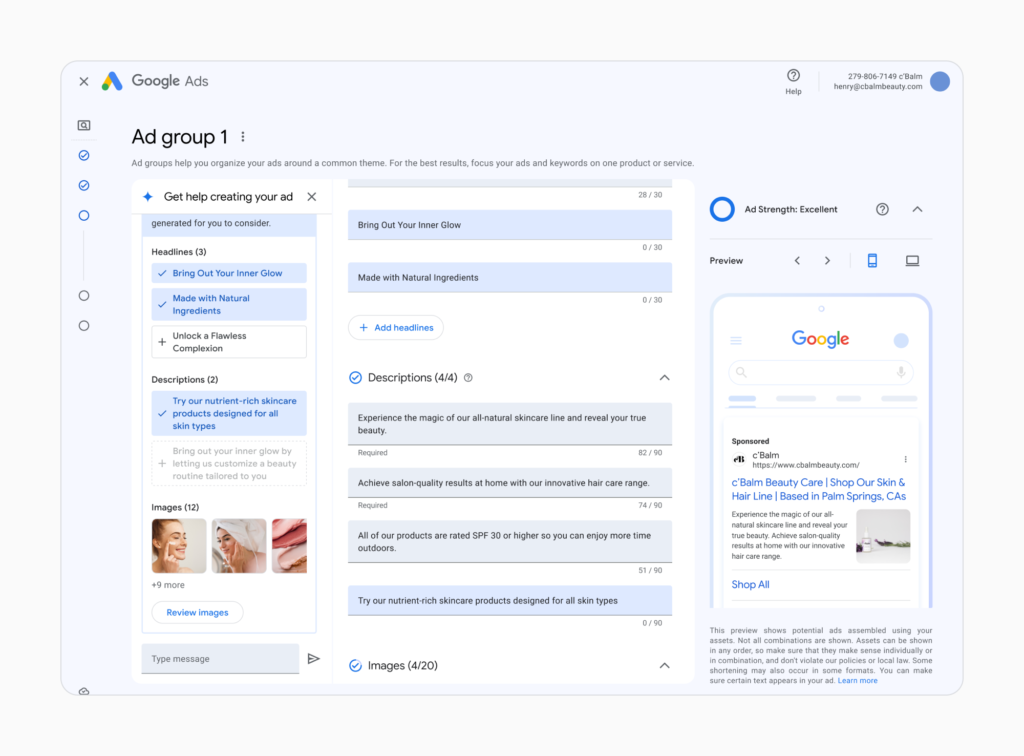
Image credit- Google
Google’s Ongoing Application of Generative AI
By offering a more automated and effective workflow, the new generative AI features coming to Google Ads seek to reduce the complexity of contemporary digital advertising. Advertisers should be able to quickly handle changing customer behavior and the increasing need for more individualized and successful advertising tactics thanks to these new technologies. Google’s AI-powered upgrades to its ad platform offer capabilities that might greatly speed up the production and placement of ads, making them more effective and targeted in a world that is becoming more automated.
Read More: Google Secretly Alters Ad Auctions to Boost Revenue Targets
Google Secretly Alters Ad Auctions to Boost Revenue Targets
Google has acknowledged that it modified ad auctions covertly to hit revenue targets. The search engine regularly modifies the auctions it employs to sell search advertisements, raising the cost of ads and reserve pricing for the typical advertiser by as much as 5%. A Google executive acknowledged that the price of advertising fluctuated during the auction process to satisfy revenue goals. This week, Google’s advertising tactics were highlighted in an ongoing federal antitrust trial.
Google’s Executive Testimony
According to testimony from Jerry Dischler, Vice President and General Manager of Google’s Advertising Products, the company modifies its ad auctions to achieve set revenue goals. These modifications include price hikes of up to 5% without the advertiser’s knowledge. He admitted to the U.S. Justice Department during the Antitrust Trial that the business may have raised pricing for some inquiries by as much as 10%. The testimony is a piece of a bigger lawsuit in which the US DOJ accuses Google of illegally maintaining a monopoly on online search. As the trial goes on, more and more details are emerging about Google’s pricing adjustments, its rivalry with Amazon, and the effects of its policies on advertisers.
Read More: Google Boosts Performance Max with URL Contains Targeting Tool
Advertising Practices of Google
During the federal inquiry, Dischler also disclosed that the internet behemoth frequently modifies its ad auctions. Without telling advertisers, these changes are made with the intention of selling search advertising. He also expressed worries about revenue and the potential impact on employee morale of a big decline in Google’s stock price. This applies particularly to teams in expensive areas. He also made it clear that his intention was to think outside the box so they could fulfill their quota. The majority of Google’s income comes from search adverts. According to Dischler, the corporation will make more than $100 billion from search ads in 2020. Since 2012, Google’s ad revenue growth, according to the DOJ, has regularly been in the high teens.
So I always knew this was the case, but to see it actually stated by the VP of ads is astounding!
And what do you think smart bidding is? A smart way for Google to be able to easily manipulate ad prices! SMH pic.twitter.com/rwvpCmWC0M
— Anthony Higman (@AnthonyHigman) September 19, 2023
Changes in prices and Increasing Competition
Dischler acknowledged that some adjustments to auctions led to a 5% rise in expenses for regular marketers. In certain cases, price increases reached 10%. Nevertheless, he thought that a 15% price hike would cause the majority of marketers to go to rivals like Meta Platforms Inc. or ByteDance Ltd.’s TikTok. Even so, he admitted that he had no reason to think that Google wouldn’t continue to attract enough advertisers to grow its revenue.
Read More: Google Unveils Fresh Consent Management Rules for EEA and UK
The threat from Amazon
When it comes to retail advertising, Amazon is growing twice as fast. Amazon is currently posing a serious threat to Google in the retail advertising market. Dischler acknowledged that companies that make consumer goods have threatened to switch their advertising budgets from Google to Amazon.
Why do tweaking ad prices matter?
The argument made by the Justice Department that Google has an unlicensed monopoly may be strengthened if Google can increase ad prices without seeing considerable competition. Given that Google’s search engine is a free offering for users, the government is unable to apply this defense against Google itself. They can counter that greater competition might have addressed other problems like search industry privacy requirements.
Why did Google tweak search ad auctions?
To ensure that his team exceeded the sales goals that Google CFO Ruth Porat had communicated to Wall Street, according to Dischler, staff members allegedly shook the cushions. He penned the following to his employees in an email in May 2019:
If we don’t meet quota for the second quarter in a row and we miss the street’s expectations again, which is not what Ruth signaled to the street, so we will get punished pretty bad in the market. I care more about revenue than the average person but think we can all agree that for our teams trying to live in high cost areas another $100,000 in stock price loss will not be great for morale, not to mention the huge impact on our sales team.
Read More: Imagine Communications Join Forces with Google Ad Manager
Google Boosts Performance Max with URL Contains Targeting Tool
Performance Max (PMax) campaigns now include the ‘URL Contains Targeting Functionality’ feature from Google. The tech behemoth has yet again raised the bar in the fiercely competitive field of digital marketing. It is poised to transform marketing tactics with its latest product, URL Contains Targeting Functionality for PMax. The multinational software company has always sought to connect its technology with the goal of giving advertising useful solutions. By providing a clever gateway between advertisers and their target demographic, this feature raises the bar once again. Advertisers can manually specify the URL to show the PMax advertisements using the capability, which is also accessible in Dynamic Search advertisements (DSA).
What is Performance Max Campaigns in Google Ads?
PMax campaign is a Google Ads campaign type. What distinguishes it from the competition is its capacity to integrate smart bidding and targeting elements into a single goal-based campaign across the whole Google Network. It utilizes all of Google’s advertising platforms. PMax’s main objective is to assist advertisers in growing their visibility and conversions within the Google Network. The campaign type uses smart bidding, an AI-driven automated bidding technique, to optimize ad performance in real time. Depending on what is most effective at a specific place and time, advertisements are displayed in a variety of formats.
How does a PMax Campaign work?
Ad Optimization
Ads are automatically and dynamically optimized utilizing data provided by advertisers (including various assets tailored to each advertising channel, such as photos, videos, logos, and ad content).
Cross-channel advertising
Performance Max may choose when and where to display adverts across the Google Advertising Network. This is possible thanks to machine learning technologies. PMax displays ads where the target audience is most likely to interact.
Bidding and budget strategy automation
It uses ML and automation to increase conversions and maximize budget efficiency.
Campaign issue identification
Detects campaign problems automatically and offers a diagnostic insights tool. Every time a potential issue arises in relation to an account, billing, campaign status, some policy violations, ad strength, budget, and more, advertisers receive immediate alerts that include solutions to troubleshoot the issue.
Read More: Google’s Triple Treat- Unleashes a Trio of Updates to Elevate User Experience
A Deep Dive into URL Contains Targeting Functionality
Advertisers can manually specify the URL where the PMax adverts are displayed by using the URL Contains Targeting tool. It substantially improves ad optimization by enabling the deliberate routing of users to certain URLs, like blogs or about us pages.
The significance of URL functionality to advertisers
Advertisers can use this essential feature to remove non-monetizable pages from their ad campaigns. It gives them the ability to target and provide ads to audiences that are most appropriate for their offerings. By focusing on the URL-included feature, marketers may enhance conversions
URL Contains Targeting Functionality- How does it work?
Advertisers can target particular pages using URLs that contain a particular text string, or “Token.” It is important to note that a text fragment enclosed by a delimiter (:, /,?, +, &) is referred to as a token within URLs. It‘s vital to keep in mind, though, that this capability does not apply to all URL types. It cannot be utilized, for instance, with URLs like “electronicexample.com/servicemenu” since the term MENU is present after the targeted keyword SERVICES. However, URLs like “electronicsexample.com/services-menu/” are compatible with this feature. This is due to the ‘-‘ separating the keyword SERVICES from the word MENU.
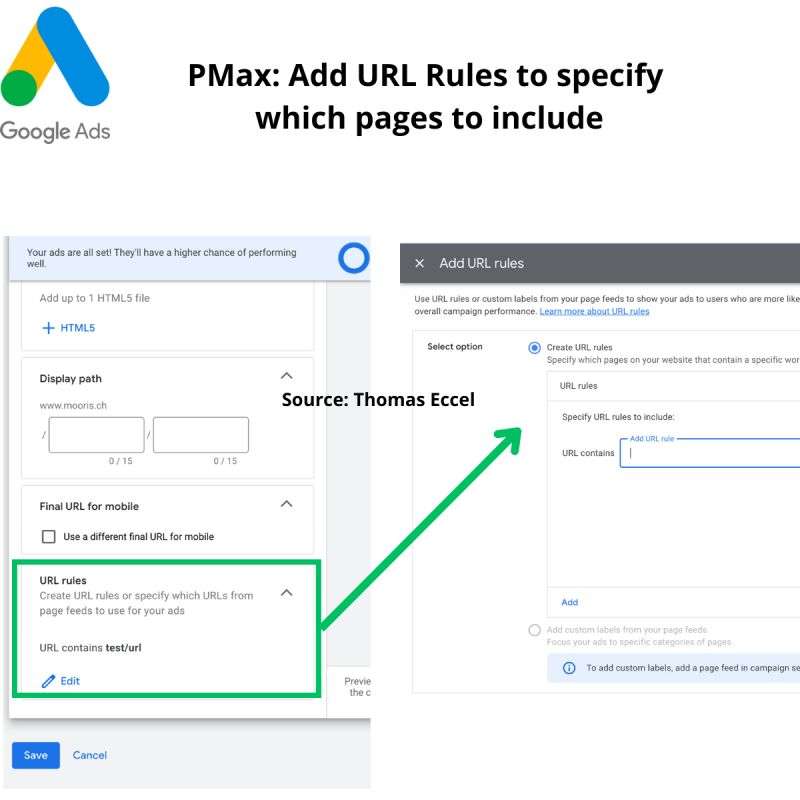
Image credit- Thomas Eccel. LinkedIn
Google’s URL Contains Targeting Functionality that eliminates uncertainty in ad tactics at a time when digital marketing is constantly changing, allowing advertisers to increase their reach and impact. With such potent features, it’s intriguing to wonder what Google may release next.
Here’s what they said
As reported by Search Engine Land, Google said
This is a new feature rolling out for Performance Max. We are bringing the same URL Contains targeting functionality from Dynamic Search ads (DSA) into Performance Max to better support DSA use cases in PMax as part of the voluntary upgrade we announced in July. This feature works exactly as it does in DSA today.
Read More: Google Unveils Fresh Consent Management Rules for EEA and UK
Google Unveils Fresh Consent Management Rules for EEA and UK
EEA and UK advertisers and developers who use Google AdSense, Ad Manager, or AdMob for ad serving will need to use the new consent management platforms (CMPs) starting next year. The Transparency and Consent Framework (TCF) of IAB Europe (the Interactive Advertising Bureau) has been incorporated into this platform and received Google certification. Google is always searching for ways to improve consent experiences in order to meet consumer needs and statutory measures. This demonstrates their commitment to transparency and control.
CMPs consent requirements
For CMPs collaborating with its partners who use display ads in the EEA and the UK, Google has implemented a novel rule. Ad Manager and AdMob partners have until January 16, 2024, to adopt the CMP adjustments. Google-approved CMPs evaluate against Google’s certification requirements focusing on TCF compliance. Publishers who fail to comply will face restrictions from delivering ads to EEA and UK audiences. The rule also covers the use of AdSense, Ad Manager, or AdMob. When serving ads, they will have to connect the verified CMP to the TCF.
Google has also stated that traffic from Google-certified CMP will continue to qualify for limited, personalized, and non-personalized (NPA) advertisements. Google will seek authorization for both on-platform and off-platform reconciliation. They further indicated that CTV inventory is not currently subject to CMP regulations.
CMPs that collaborate with its publishing partners. It will keep trying to certify them in accordance with the certification standard. Google thinks the advertising sector can develop a more consistent and trustworthy system for disclosure and consent by embracing IAB Europe’s uniform framework. Additionally, these activities will promote a more security-conscious digital advertising environment and the current advancements in user privacy.
The Transparency & Consent Framework (TCF).
The IAB’s TCF v2.2 is becoming a crucial component in supporting the industry participants, including Google, which is currently restructuring its framework to align with this. It has significantly altered Europe’s data privacy landscape. The TCF is a tool for transparency that depends on standardization. It makes it easier to comply with GDPR and the ePrivacy Directive’s specific requirements. It applies applicable concepts and requirements drawn from EU-level guidelines from the EDPB and national-level guidelines from Data Protection Authorities, to the unique situation of the online industry.
The TCF is an industry-wide voluntary norm placed on technology partners that support the distribution, personalization, or evaluation of advertising and content (third parties or vendors). It aims to assist them to collaborate with publishers of apps and websites (first parties) to offer users a standardized experience when they make privacy choices.
Users have the option to give or withdraw consent as well as exercise their “right to refuse” the processing of personal data through TCF. It contains basic practical standards for educating users, giving them privacy choices, and respecting those choices that are derived from guidelines of Data Protection bodies and the law.
Read More: Antitrust Complaint Filed Against Google in the EU!
What is the EU user consent policy?
According to this policy, advertisers must ensure specific disclaimers and consents are received from end users in the EEA and the UK. This will be done in case they choose to include or use any of the Google products that implement the policy. In the event of non-compliance, usage of Google products may be restricted or suspended, and the agreement may be terminated. The publishers must legally get the end users’ authorization before collecting, distributing, and using personal data for individual advertising. It is also crucial to keep track of the end users’ consent and give them explicit information on how to withdraw their consent.
A quick look at personalized and non-personalized ads
Personalized ads
Previously called interest-based advertising, it is a robust technique that enhances advertising authenticity for users while increasing ROI for advertisers. They enhance both the user and advertiser experience by enabling advertisers to focus their campaigns on user interests. Personalized ads are ads chosen for display based on previously gathered or past data. The user’s past search queries, actions, visits to websites or apps, interests, remarketing, etc are all included in this.
Non-personalized ads
These adverts do not predicate on previous user activity. They focus on users based on relevant data, like basic geo-targeting, the user’s location, web or mobile content, and keywords. NPA uses cookies or mobile ad identifiers for frequency capping, aggregated ad reporting, and contest ad fraud and abuse. One must get consent before using cookies or mobile ad tags as per the ePrivacy Directive in some EEA countries. NPAs will only be provided to users who have signed in with Google in the EEA and shared their age under-age consent set by GDPR.
Read More: Meta Adopts Consent Policy for Targeted Ads Data in Europe
Google Rolls Out Advert Target Frequency For YouTube Campaigns
Google rolled out ad frequency targeting for YouTube campaigns. Showing the same ads to the same people, again and again, neither benefits the advertisers nor the viewers. However, can affect the brand’s reputation. So, achieving the right video ad frequency for both viewers and advertisers has always been a juggling act.
In line with this, Google rolled out target frequency giving advertisers control over how many times an ad is shown on YouTube. Previously, controlling ad frequency on YouTube was only possible when running connected TV campaigns in Google Display & Video 360. However, Google is taking a step further and making it globally available for all advertisers running YouTube campaigns.
Interesting Read: On Connected TVs, YouTube Makes Its Ads More Shoppable!
How will it help advertisers globally?
Whenever the same ads are shown to the same people repeatedly, there is always a risk of low returns. It is inevitable that viewers will tune out and sales will suffer as a result of the added impressions. It is an annoying experience for viewers to watch the same ad repeatedly and proves wasteful for advertisers.
In the blog, the tech giant explained the launch of target frequency globally for Youtube campaigns will help the marketers harness the impact.
This will help advertisers optimize towards more precise reach and frequency while ensuring that we continue to provide a suitable advertising experience for viewers. Target frequency allows advertisers to select a frequency goal of up to four per week and our systems will optimize towards maximum unique reach at that desired frequency.
A MMM meta-analysis commissioned by Nielsen shows on average, TV advertisers’ return on investment (ROI) decreased by 41% when frequency exceeded 6+ weekly impressions — which represents 46% of TV impressions served. Google inferred from the study that almost half of the impressions were wasted. However, Google explained that the same study shows brands can increase the frequency.
The same study from Nielsen shows that brands can increase their average weekly frequency from one to three on YouTube with a consistent ROI. This is a huge opportunity for marketers to maximize their impact across the same set of people they are already reaching today.
The frequency management solution on YouTube will help advertisers deliver a better advertising experience for viewers without any compromise in ROI. Advertisers can select the frequency target and the systems will optimize towards maximum unique reach at the frequency goal. Over 95% of Target frequency campaigns on YouTube successfully achieved their frequency goals when set up following recommended best practices. Not only do the campaigns deliver on their target frequency, but they drive brand impact as well.
Partnered with Triscuit
Google partnered with Triscuit to analyze how the brand can drive incremental impact to its reach campaigns with a frequency target. It set up a Video experiment to determine the incremental ad recall that a weekly frequency of two could deliver. The Target frequency campaign achieved a 93% higher absolute ad recall lift compared to the non-frequency optimized campaign, at a 40% cheaper cost per lifted user.
Interesting Read: Bridging The Gap: Is YouTube Unifying Linear And CTV Ad
Is Apple Secretly Buying Google’s Search Advertisements?
Apple is said to be discreetly purchasing Google search advertisements for high-value apps on the App Store. Because Apple gets a 15% to 30% share of the app and in-app sales, some developers believe is affecting their revenue.
Apple is “secretly” paying Google advertisements that send consumers to an app’s App Store listing rather than the developer’s website, according to multiple app publishers who spoke to Forbes.
One source told Forbes,
“Apple is trying maximize the money they’re making by driving in-app purchases that people buy through the Apple Store. Apple has figured out that they can make more money off these developers if they push people to the App Store to purchase there versus a web flow.”
Interesting Read: Snapchat Sees a 20% Plummet In Revenue Due To Apple’s Privacy Changes!
Masterclass, HBO, Babble, Tinder, and Bundle are among the applications that have been marketed in Google searches, according to the report. The advertiser isn’t identified in the ads, but they all have essentially similar tracking data, indicating that they’re all purchased by a single business.
It’s worth mentioning that Forbes was unable to confirm that Apple was the buyer of the ad slots. Developers provided such information. It’s most likely due to the fact that the app developers didn’t pay for the advertising and that they all lead to an App Store link.
Also Read: Apple Will Now Ask Permission Before Showing Its Own Targeted Ads
Google Ads Launches Performance Max To All Advertisers Globally
Google ads announced an expanded rollout of Performance Max campaigns to all advertisers globally that will help them to drive more conversions.
What Is It About?
Last year, Google introduced Performance Max campaigns which enable users to buy ads across multiple platforms, including YouTube, Display, Search, Discover, Gmail, and Maps, with one single campaign. In addition to keyword-driven Search campaigns, they complement Google’s full suite of advertising channels and inventory.
Google Ads launched Performance Max campaigns in beta last year, and advertisers that tested the service saw an average of 13% incremental conversion increase.
Performance Max campaigns will start to roll out to all advertisers today! This new campaign type can help you drive more conversions across all of Google’s ad inventory.
Check out new best practices and case studies → https://t.co/n0VEGlqPvg pic.twitter.com/jfgL2n3NoN
— Google Ads (@GoogleAds) November 2, 2021
Interesting Read: Neeva : An Ad-Free Search Engine Launched By Former Google Ads Head
How Will It Help Advertisers?
Performance Max helps increase online sales, generate leads, or grow offline sales. It helps you achieve your goals in four main ways:
- Increasing conversions and value: Capitalize on new conversion opportunities by adjusting automated bids across channels in real-time.
- Finding new customers: Google’s real-time understanding of user intent, behavior, and context can help you create more relevant ads to target new audiences.
- Gaining richer insights: Performance Max campaigns are now included in the insights page.
- Working together with automation: Get better results through automation by providing high-quality creative assets and insights into which audiences convert well.
MG, Deezer, and Allianz are brands that have used the beta version of the campaign. Marketers report that it helped them improve their conversion rates, find new customers, and understand consumers better.
Interesting Read: Google Gives A New Look For Attribution Reports in Google Ads
New Features In The Works
The Google Ads team announced that next year it will add more Performance Max features specifically for retailers. Retailers with local inventory feeds will see new Search and Maps ad formats integrated with their products to help increase foot traffic to their stores. Furthermore, Smart Shopping and Local campaigns will be upgraded next year.
Eduardo Indacochea, Google, senior director of product management said in a blog post,
“We know the holidays are a critical time of year for your business. You should continue using Smart Shopping and Local campaigns to reach more shoppers across online and in-store experiences this holiday season.”
He further added,
“However, when the time is right for your business, you can start testing Performance Max campaigns before next year’s campaign upgrades.”
Google plans to continue investing in Performance Max and improving its automation technology in order to help businesses succeed.
Interesting Read: The Ultimate A-Z Glossary Of Digital Advertising!
Google To Demonetize Ads That Spread Climate Change Misinformation
Last year, Google-owned YouTube announced that it will prohibit all anti-vaccination content on its platform except for COVID-19-related information. This time – Google is targeting climate change misformation.
In an attempt to debunk myths about climate change and discourage the denial of the phenomenon, Google recently stated that it is censoring information on its network that undermines well-established scientific data, effectively shutting out climate naysayers.
Interesting Read: Google’s New Advertising Page Will Show Brand’s Recent Ad History
After media buyers and content producers voiced reservations about ad misplacement, the tech giant revised its advertising policy to ban misinformation about climate change.
According to a company blog post, Google is targeting advertisers and publishing partners in Google-served ads who attempt to encourage climate change misinformation on pages and videos. It is also focusing on YouTube Partner Program creators attempting to monetize their climate change misinformation videos.
The blog post read –
“We’re announcing a new monetization policy for Google advertisers, publishers, and YouTube creators that will prohibit ads for, and monetization of, content that contradicts well-established scientific consensus around the existence and causes of climate change”
Interesting Read: Neeva: An Ad-Free Search Engine Launched By Former Google Ads Head
Google Ads : New Monetization Policy
Google’s new regulation specifically targets statements that claim climate change to be a “hoax or scam.” Furthermore, any claims that contradict long-term environmental patterns, and those that disregard crucial factors in climate change, such as greenhouse gas emissions or human activity causing climate change, are all targeted by the revised policy.
On climate-related issues, such as educated discussions on climate change and reliable research, Google will continue to allow advertisements and monetization.
Google made an official statement saying –
“We’ll look carefully at the context in which claims are made, differentiating between content that states a false claim as fact, versus content that reports on or discusses that claim”
Also Read: Google Is Reportedly Planning to Index Instagram and TikTok Videos

